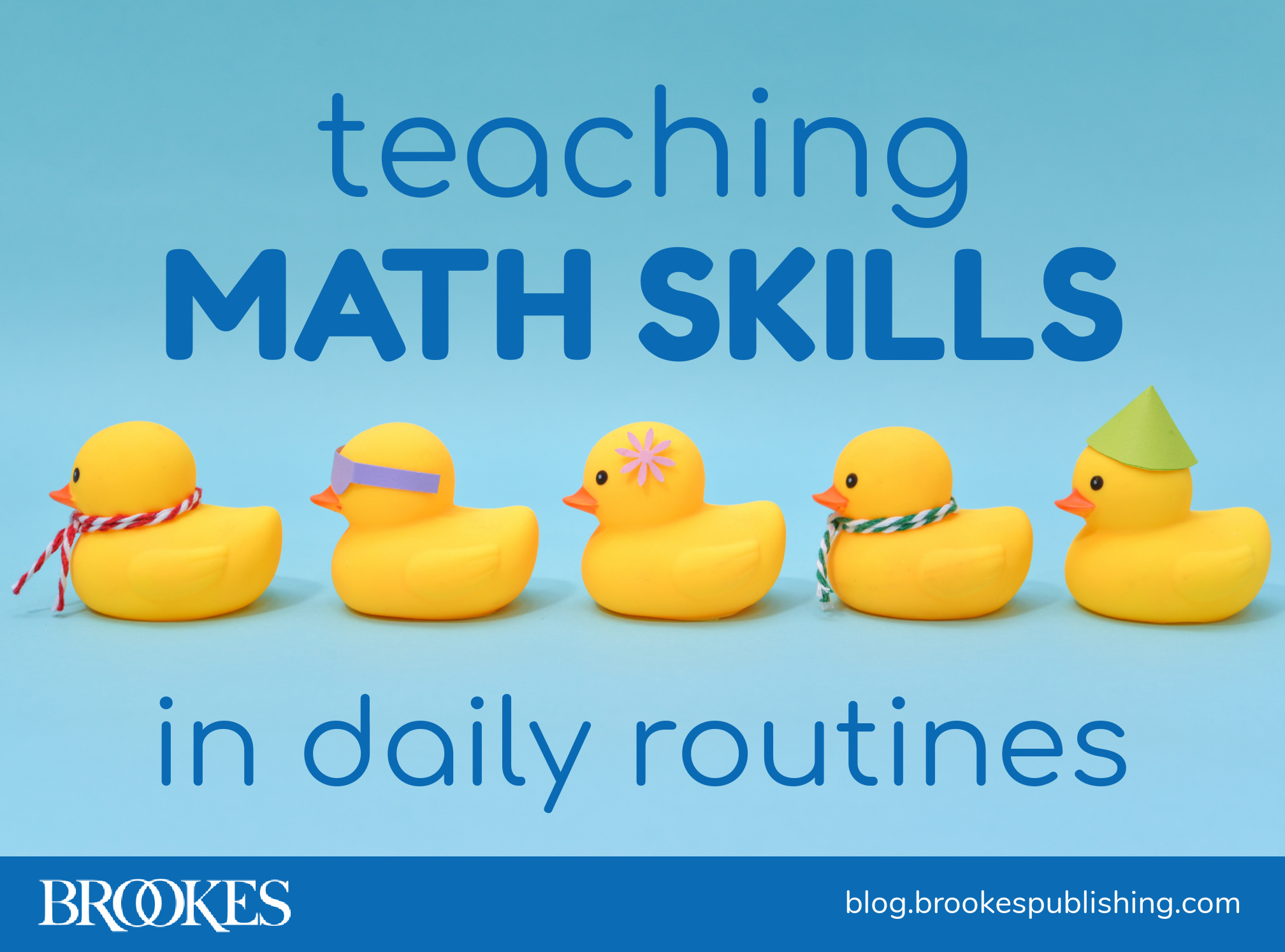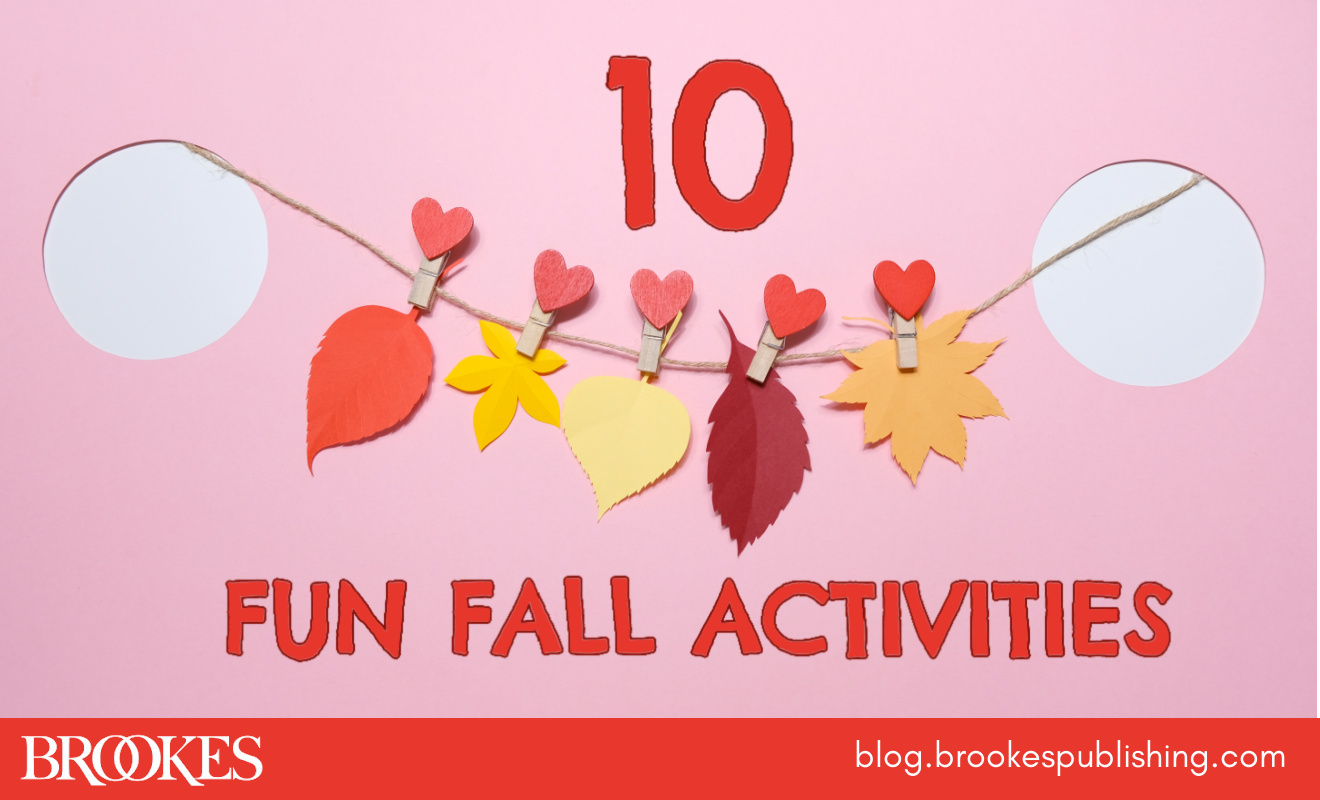Fall is finally here! As we say goodbye to sweltering summer heat and get ready for cider, falling leaves, and pumpkin spice everything, what activities are you looking forward to doing with the young children in your life?
In today’s post, we’re sharing 10 activities you can try with young children this fall to have fun with them, celebrate the beauty of the season, and boost key developmental and social skills. Easily adaptable for school and home, these activity ideas were adapted from some classic Brookes books (see the end of the post to learn more). See which ones you might want to try this year—and if you have a favorite fall activity of your own, share it in the comments below!
 Classify autumn leaves. Collect a bag or tub full of leaves (or have children collect them while they are outside that day or the day before). Tell children that they are going to sort the leaves. Model sorting for them by picking up two leaves with a contrasting feature (e.g., one is big and one is small, or one is pointy and one is smooth, or one is green and one is red). Put one of the leaves in a pile or tub and say something like “This one is big, so I am putting it here. This other one is small, so it goes here.” Then pick up medium-sized green and red leaves and ask the children where these leaves should go. Explain that if they don’t fit into the piles already established, a new pile can be made. This activity is a fun way to promote listening, fine motor, and cognitive skills.
Classify autumn leaves. Collect a bag or tub full of leaves (or have children collect them while they are outside that day or the day before). Tell children that they are going to sort the leaves. Model sorting for them by picking up two leaves with a contrasting feature (e.g., one is big and one is small, or one is pointy and one is smooth, or one is green and one is red). Put one of the leaves in a pile or tub and say something like “This one is big, so I am putting it here. This other one is small, so it goes here.” Then pick up medium-sized green and red leaves and ask the children where these leaves should go. Explain that if they don’t fit into the piles already established, a new pile can be made. This activity is a fun way to promote listening, fine motor, and cognitive skills.
Have an indoor harvest. This is a good activity to try with a group of children—it helps boost communication and social skills as well as motor skills. Mark off sections in a play area with masking tape, cardboard bricks, or pretend fencing. Set up a pumpkin patch with paper or real miniature pumpkins, an apple orchard (cardboard tree shapes with painted Ping-Pong balls attached with Velcro), and/or a cornfield area stocked with real corn stalks or Indian corn. Have the children pretend to harvest the crops. You can count apples and pumpkins as kids put them in the baskets, compare and contrast the physical characteristics of the produce, and teach kids how to shuck the corn. After the harvest, you might want to set up a “farmer’s market” area where kids can buy and sell their produce with pretend money.
Do some leaf rubbings. A fall classic, this activity is excellent for strengthening fine motor skills. Collect a variety of leaves with children, or provide them with a bag full of leaves to choose from. Have children place a leaf or several leaves under a piece of white paper and then rub a crayon (with its paper covering removed) over the paper back and forth until the shape of the leaf appears. Point out that they can use different colors of crayons and different arrangements of leaves under the paper to make a variety of pictures.

Decorate a haunted house. Do you have a play house or play tent in your classroom or home? Build motor and social skills by inviting children to turn it into a spooky haunted house. Provide them with decorations, or have them make their own: paper bats, Kleenex ghosts, cotton spider web, construction-paper skeletons. If the house is on the small side, you can give it a special Halloween extension by adding a large cardboard appliance box so kids have more space to decorate. After the decorations are up, the kids can have a party in their haunted house.
Name Smiley’s bones. Another activity to try in conjunction with Halloween, Smiley’s Bones can hone listening skills, increase conceptual knowledge, and reinforce group interaction and turn-taking skills. You’ll need a plastic or cardboard-cutout skeleton where the bones are clearly defined. Tell children that “Smiley” has a lot of bones, and that they’re going to take turns finding some of the bones. Ask each child to point to one of Smiley’s bones (hand bones, wrist bone, arm, leg, shoulder, head, jaw) and then locate these bones on their own bodies. Some kids might also be interested in learning the scientific names of some of the bones: femur is a leg bone; radius and ulna are arm bones, and patella is the kneecap.
 Explore and observe a pumpkin. Carve out some time to practice cognitive and problem-solving skills with this pumpkin-themed science activity. Bring in a pumpkin (or take your kids pumpkin-picking) and teach children about the scientific concept of observation. Have children identify the pumpkin and make a list of the things they know about it. Encourage them to use their observation skills to look at the color and shape of the pumpkin and any specific details they notice. Ask kids to make predictions about what the inside of a pumpkin looks like and how much it weighs, and record their observations. The next day, discuss the observations made the day before. Weigh the pumpkin and cut it up so children can observe the insides. (You can also do this with another fall fruit or vegetable, such as an apple or squash.)
Explore and observe a pumpkin. Carve out some time to practice cognitive and problem-solving skills with this pumpkin-themed science activity. Bring in a pumpkin (or take your kids pumpkin-picking) and teach children about the scientific concept of observation. Have children identify the pumpkin and make a list of the things they know about it. Encourage them to use their observation skills to look at the color and shape of the pumpkin and any specific details they notice. Ask kids to make predictions about what the inside of a pumpkin looks like and how much it weighs, and record their observations. The next day, discuss the observations made the day before. Weigh the pumpkin and cut it up so children can observe the insides. (You can also do this with another fall fruit or vegetable, such as an apple or squash.)
Set up an autumn-themed scavenger hunt. This activity is a great booster for problem-solving skills and communication, and it’s a favorite of children everywhere. Hide fall-themed “treasures” such as miniature pumpkins (plastic or real), apples, stuffed squirrels and turkeys, and leaf-shaped stickers in places the children can reach. Make a list of items and ask children to work together to hunt them down. Be sure to celebrate when all the treasures are found!
Make some autumn leaf notecards.

Collect colorful leaves from your yard, neighborhood, a park, or a roadside. (Leaves that are small and delicate work best.) Place the leaves between sheets of paper towels or newspaper, and then lay them between heavy books.
Give the leaves a few days to dry and flatten out. When they’re dried, have children glue them to a folded piece of paper or cardstock to make notecards. Help children write someone a special note or ask them to draw a picture inside the card for the person they want to give it to. A great way to reinforce fine motor skills!
Have fun with a fall “feely bag.” Gather small, familiar fall-themed objects from outside or around the house and put them in a paper bag or sack (you can decorate the bag with leaves, pumpkins, and other autumnal images). Some ideas for the feely bag include a leaf, a small plastic pumpkin, an ear of Indian corn, a gourd, or small stuffed or plastic turkeys. Let children take turns reaching into the bag and picking an item without looking. When the child’s hand is in the bag touching the item, ask them to guess what it is.
Engage with autumn-themed books.

Shared reading is one of the most important activities you can do with a young child—it strengthens children’s communication and language skills, boosts social-emotional development, and sets the stage for early literacy development. At home and in the classroom, choose autumn-themed books and engage children while you read: ask them what happened at the beginning, middle, and end of the story, or have the child act out the story with you and pretend to be different characters. To support social-emotional skills (especially important as children struggle with the continuing effects of the pandemic), read books about feelings and talk with children about the story: “Lion got really scared in this story. Do you feel scared sometimes? What makes you feel better when you get frightened or worried?” (For more tips on making the most of shared reading with children, check out this post. And for good recommendations for autumn-themed books to read at school or at home, see this Scholastic list and this list of books that incorporate STEM and diversity.)
With the activities in this article—and your own creative ideas—you can infuse your autumn days with fun while you build skills that kids will use forever. Whatever fall activities you choose to do with children at home and at school, have a great time exploring, discovering, and learning together!
Activities should be supervised at all times by an adult. Any material, food, or toy given to a young child should be reviewed for safety.
EXPLORE THE BOOKS
The activities in this post were adapted from and inspired by the following books:
Activities 1-5: Early Literacy in Action by Betty H. Bunce
Activity 6: Preschool Pathways to Science (PrePS™) by Rochel Gelman, Kimberly Brenneman, Gay Macdonald, & Moises Román
Activities 7-10: ASQ®-3 Learning Activities by Elizabeth Twombly and Ginger Fink
Stay up to date on the latest posts, news, strategies, and more!
Sign up for one of our FREE newslettersMore posts like this

Math All Day: 14 Ways to Teach Young Children Math Skills During Daily Routines
April 13, 2021
24 At-Home Learning Activities to Share with Parents of Young Children
March 17, 2020


Write a Comment
Your email address will not be published. Required fields are marked *
Post a Comment